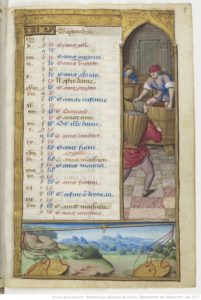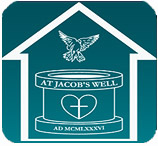
“September”, kalendar page from Les Petites Heures d’Anne de Bretagne (The Little Hours of Queen Anne of Bretagne), by the Maître des Triomphes de Pétrarque. From Bibliothèque nationale de France, Paris (France).
Several of the legends associated with Ciarán are bovine-centered. First, when Ciarán set out for Clonard from home, he asked to take one of the family cows as a contribution to the community. His mother refused this request, so he blessed one of the cows, and she followed him of her own accord. Her calf wanted to follow along, but Ciarán drew a line on the ground with his staff to separate the two animals, and the calf obediently remained behind. This cow, which was dun colored, was a prodigious milch cow, providing the entire monastery with milk all on its own. (“Dun” is a dull brownish grey, and it should be noted that dun cows are a common motif in English folklore.)
When the cow died (it’s not clear whether it outlived Ciarán, but that seems likely), it was skinned and its hide kept as a relic. Centuries later, that hide (so the tradition goes) was used to make the pages of the Book of the Dun Cow (the Leabhar na hUidhre, in Irish), the oldest manuscript in the Irish language. It contains both religious and secular entries, such as “The Vision of Adomnán”; “The Cattle Raid of Cooley”, the oldest version of the central epic of the Ulster Cycle; “Cúchulainn’s Phantom Chariot”, in which Saint Patric raises Cúchulainn from hell to convince king Lóegaire mac Néill to convert to Christianity; and “The Cause of the Battle of Knock”, about the birth of the great hunter-warrior Fionn mac Cumhaill.
Ciarán’s feast day is 9 September.


